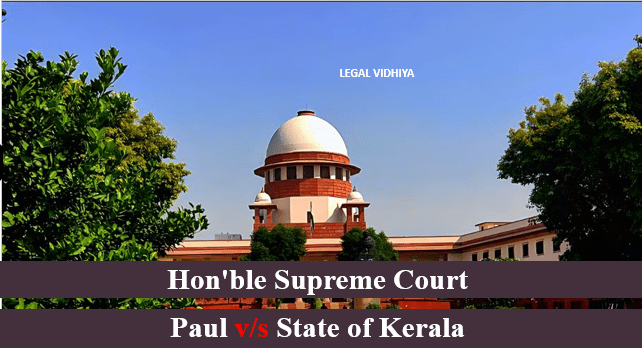
| Citation | CRIMINAL APPEAL NO.38 of 2020 |
| Date of Judgement | 21 January, 2020 |
| Court | Supreme Court |
| Appellant/Petitioner/Plaintiff | Paul |
| Respondents/Defendant | The State of Kerala |
| Bench | Mohan M. Shantanagoudar, K.M. Joseph |
FACTS-
- On 31.8.1997, the appellant married Jessy. According to the prosecution, Jessy has been the victim of physical and emotional abuse at the hands of the appellant and his mother ever since their marriage. The appellant’s mother caused a disturbance at their house on 11.10.1998, which would prove to be the turning point. The deceased’s wife was drinking with his friends when she left the house in a melancholy state in search of him because of intolerable pestering. Before them, the appellant battered his wife. Later that same night, at about midnight, the appellant choked her to death.
- The appellant and the deceased wife were living in a separate bedroom. The appellate court observed that the appellant did not contest the assertion that both he and his wife were available in the bedroom at all hours of the night. Regarding how the deceased’s injuries were sustained, he didn’t take a firm stance.
- The Evidence Act’s Section 106 imposed obligations on the appellant. The hypothesis of suicide was rejected since the appellant was determined to have killed by throttling. The High Court took note of the appellant’s wife’s suicide at 1.30 a.m. by hanging herself from their room’s window grill. The High Court agreed that the appellant’s murder was the only explanation that could be true.
ISSUES-
- Whether the accused is liable for the murder of the deceased?
JUDGEMENT-
- After reviewing the case on remand, the Principal Sessions Judge entered the following conclusions, among others. It was discovered that the dead man’s neck had been struck with a blunt object, which had an immediate fatal effect. A case under Section 498A was not made out, the learned Judge continued.
- It was finally held by the SC that, The appellant’s death was a culpable homicide, falling within the scope of Section 300 of the Indian Penal Code (IPC). The act, which resulted in injuries, falls within the scope of Section 304 Part-I or Part-II.
- However, Section 304 would only apply in cases where culpable homicide is not murder. If the act satisfies any of the four criteria to bring it under the offence of murder, there can be no scope for applying Section 304.
- If the act is culpable homicide as falling in any of the five exceptional circumstances mentioned in Section 300, it would amount to culpable homicide not amounting to murder. If the accused can establish he is entitled to the benefit of any of the exceptions under Section 300, his case may be considered under Part-I or Part-II of Section 304 of the IPC depending on whether the act was done with the intention of causing death or with knowledge that it is likely to cause death.
- However, if the case falls under any of the four limbs of Section 300, there would be no occasion to allow Section 304 to have play. The appellant’s contention that it would be culpable homicide not amounting to murder is wholly meritless.
REFERENCES-
- Indiankanoon.com
- CaseMine.com
This Case analysis is written by Anshula Grover, intern at Legal Vidhiya and a student at Shoolini University.
Disclaimer: The materials provided herein are intended solely for informational purposes. Accessing or using the site or the materials does not establish an attorney-client relationship. The information presented on this site is not to be construed as legal or professional advice, and it should not be relied upon for such purposes or used as a substitute for advice from a licensed attorney in your state. Additionally, the viewpoint presented by the author is of a personal nature.




0 Comments